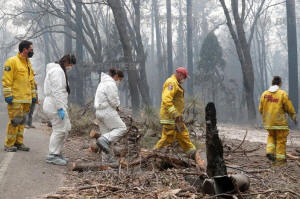|
National Guard to help search for remains
from California's deadliest wildfire
 Send a link to a friend
Send a link to a friend
[November 14, 2018]
By Terray Sylvester
PARADISE, Calif. (Reuters) - National Guard
troops were due to arrive on Wednesday to help search for more victims
in the charred, ash-strewn ruins where the northern California town of
Paradise stood, before it was erased in the deadliest, most destructive
wildfire in state history.
The Guard contingent, about 100 military police trained to look for and
identify human remains, will reinforce the coroner-led recovery teams,
cadaver dogs and forensic anthropologists already scouring the ghostly
landscape of a fire that has killed at least 48 people.
The grim, painstaking search is concentrated in what little is left of
Paradise, a Sierra foothills town in Butte County, California, about 175
miles (280 km) north of San Francisco, that was overrun by flames and
largely incinerated last Thursday.
The killer blaze, fueled by thick, drought-desiccated scrub and fanned
by fierce winds, capped a catastrophic California wildfire season that
experts largely attribute to prolonged dry spells they say are
symptomatic of global climate change.
The Butte County disaster coincided with a flurry of blazes in Southern
California, most notably the Woolsey Fire, which has killed two people,
destroyed over 400 structures and displaced about 200,000 people in the
mountains and foothills near the Malibu coast west of Los Angeles.
The origins of both the Camp and Woolsey fires were listed as under
investigation. But two utility companies, Southern California Edison <EIX.N>
and Pacific Gas & Electric <PCG.N>, reported to regulators they
experienced problems with transmission lines or substations in areas
around the time the blazes were reported to have started.
By late Tuesday, with the help of diminished winds and rising humidity
levels, fire crews had managed to carve containment lines around more
than a third of both fires, easing further the immediate threat to life
and property.
U.S. Interior Secretary Ryan Zinke and California Governor Jerry Brown
were scheduled on Wednesday to pay a visit to the areas, which President
Donald Trump declared a disaster areas, making federal emergency
assistance more readily available.
After touring some of California's earlier wildfire zones in August,
Zinke blamed "gross mismanagement of forests" because of timber harvest
restrictions that he said were supported by "environmental terrorist
groups".
While prospects for suppressing the flames grew more hopeful,
authorities pressed on with the task of accounting for those listed as
missing.
County Sheriff Kory Honea said he requested the Guard troops, along with
"disaster mortuary" crew, portable military morgue teams and specialists
from a private DNA laboratory to speed the detection and identification
of additional remains.
"We want to cover as much ground as we can," Honea said at a Tuesday
evening news conference where he announced that the six latest sets of
remains had been recovered in Paradise earlier in the day.
The fatality count of 48 already far exceeds the previous record for the
greatest loss of life from a single wildfire in California history - 29
people killed by the Griffith Park fire in Los Angeles in 1933.
[to top of second column]
|

Firefighters and members of a volunteer search and rescue crew
approach a house destroyed by the Camp Fire in Paradise, California,
U.S., November 13, 2018. REUTERS/Terray Sylvester

Honea said that in some cases victims were burned beyond
recognition, or even beyond the use of fingerprint IDs. Dental
records will be needed to positively identify some, but "dental
records might not be available if the dentist office burned to the
ground", he said.
"We're finding remains in various states," he told reporters.
"People have been badly burned. Some of them, I assume, have been
consumed."
He said it was possible that some remains might turn up only once
residents with homes still intact are able to return. More than
50,000 remained under evacuation orders.
Honea had previously said 228 people were listed as missing.
However, he said on Tuesday night those numbers were highly fluid
and that his office planned to publish a new list of missing persons
soon and would ask the public to help account for them.
He said it remained unclear how many individuals whose whereabouts
were unknown had perished or fallen out of touch in chaotic
evacuations.
Wind-driven flames roared through Paradise so swiftly that residents
were forced to flee for their lives with little or no warning.
Bodies of some victims were found in and around the burned-out
wreckage of vehicles engulfed in the firestorm as evacuation traffic
ground to a half in deadly knots of gridlock hours after the fire
erupted.
By late Tuesday, the Camp Fire had blackened 130,000 acres (52,600
hectares) in all.
The Woolsey fire by comparison has scorched 96,000 acres (39,000
hectares) of chaparral-covered rolling hills and canyons spanning
Ventura and Los Angeles counties, an area roughly the size of
Denver.
On Tuesday, white-clad forensic teams fanned out to pick through the
barren, fire-scorched lots in a town once home to 27,000 people.
On a residential street in Paradise lined with obliterated houses, a
10-member search crew wearing white protective suits and red helmets
used a dog to scour the debris.
"Look for skulls, the big bones," one forensics worker said to
others as they used metal poles and their hands to sift through
ruins. At a nearby community swimming pool, recovery workers stirred
green, darkened waters with long poles to probe for bodies.
(For graphic on deadly California fires, click https://tmsnrt.rs/2Plpuui)
(Additional reporting by Noel Randewich and Sharon Bernstein in
Paradise and Alex Dobuzinskis in Los Angeles; Writing by Steve
Gorman; editing by David Stamp)
[© 2018 Thomson Reuters. All rights
reserved.]
Copyright 2018 Reuters. All rights reserved. This material may not be published,
broadcast, rewritten or redistributed.
Thompson Reuters is solely responsible for this content. |